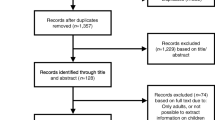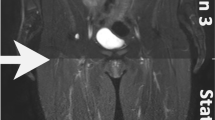Abstract
Background
Whole-body magnetic resonance imaging (MRI) is an evolving and increasingly powerful imaging tool with a variety of applications in the pediatric patient population. Variability exists among radiology practices in how this MRI tool is used and how it is performed.
Objective
Our objective was to gain an improved understanding of technical and utilization practices in pediatric whole-body MRI across North America by exploring indications for exam performance, determining referral patterns, and assessing technical protocols and procedures.
Materials and methods
A 19-question survey was generated in Survey Monkey and distributed in 2016 to the Society for Pediatric Radiology membership. The survey asked questions that included practice type, imaging modality preferences for diseases commonly evaluated with whole-body MRI, MRI field strength and sequence selection, and billing practices.
Results
Data were obtained from 62 unique responses to the survey, representing 471 physicians. The majority (93%) practice in an academic institution or private practice with academic affiliation and most practices have utilized whole-body MRI for less than 6 years. Whole-body MRI is performed in pediatric patients 0 to 18 years of age, and was the preferred imaging modality for diagnosis/staging/follow-up in neurofibromatosis, type 1 (75%), chronic recurrent multifocal osteomyelitis (CRMO) (74%), cancer predisposition syndromes (75%), vasculopathies (50%) and disseminated/multifocal infection (49%). The most commonly utilized sequences are coronal short tau inversion recovery (STIR) (90%), coronal T1 with or without fat saturation (65%), and axial diffusion-weighted imaging (DWI) (48%). No preference was shown for either 1.5-T or 3-T systems. Wide variability was seen in preference for billing code utilization, though the majority use chest/abdomen/pelvis (57%) or unlisted MRI (37%) codes.
Conclusion
Radiology practitioners – represented by the Society for Pediatric Radiology pediatric radiologists – are using whole-body MRI in the imaging care of pediatric patients for a variety of indications. Survey results reveal some variability in exam utilization and technical performance practices among those pediatric radiologists who perform whole-body MRI.
Similar content being viewed by others
References
Davis JT, Kwatra N, Schooler GR (2016) Pediatric whole-body MRI: a review of current imaging techniques and clinical applications. J Magn Reson Imaging 44:783–793
Eutsler EP, Khanna G (2016) Whole-body magnetic resonance imaging in children: technique and clinical applications. Pediatr Radiol 46:858–872
Yoon HM, Kim JR, Jung AY et al (2017) Whole body MR imaging: a useful imaging modality in the management of children with acute myeloid leukemia. Clin Lymphoma Myeloma Leuk 17:231–237
Krohmer S, Sorge I, Krausse A et al (2010) Whole-body MRI for primary evaluation of malignant disease in children. Eur J Radiol 74:256–261
Bueno MT, Martinez-Ríos C, la Puente GA et al (2017) Pediatric imaging in DICER1 syndrome. Pediatr Radiol 47:1292–1301
Ballinger ML, Best A, Mai PL et al (2017) Baseline surveillance in Li-Fraumeni syndrome using whole-body magnetic resonance imaging: a meta-analysis. JAMA Oncol 3:1634–1639
Goo HW, Yang DH, Ra YS et al (2006) Whole-body MRI of Langerhans cell histiocytosis: comparison with radiography and bone scintigraphy. Pediatr Radiol 36:1019–1031
Ahlawat S, Fayad LM, Khan MS et al (2016) Current whole-body MRI applications in the neurofibromatosis: NF1, NF2, and schwannomatosis. Neurology 87(Suppl 1):S31–S39
Arnoldi AP, Schlett CL, Douis H et al (2017) Whole-body MRI in patients with non-bacterial osteitis: radiological findings and correlation with clinical data. Eur Radiol 27:2391–2399
Aquino MR, Tse SML, Gupta S et al (2015) Whole-body MRI of juvenile spondyloarthritis: protocols and pictorial review of characteristic patterns. Pediatr Radiol 45:754–762
Hu D, Flick RP, Zaccariello MJ et al (2017) Association between exposure of young children to procedures requiring general anesthesia and learning and behavioral outcomes in a population-based birth cohort. Anesthesiology 127:227–240
Aghighi M, Pisani LJ, Sun Z et al (2016) Speeding up PET/MR for cancer staging of children and young adults. Eur Radiol 26:4239–4248
Mohan S, Moineddin R, Chavhan GB (2015) Pediatric whole-body magnetic resonance imaging: intra-individual comparison of technical quality, artifacts, and fixed structure visibility at 1.5 and 3 T. Indian J Radiol Imaging 25:353–358
Kellenberger CJ, Epelman M, Miller SF, Babyn PS (2004) Fast STIR whole-body MR imaging in children. Radiographics 24:1317–1330
Raissaki M, Demetriou S, Spanakis K et al (2017) Multifocal bone and bone marrow lesions in children – MRI findings. Pediatr Radiol 47:342–360
Chavhan GB, Caro-Dominguez P (2016) Diffusion-weighted imaging in pediatric body magnetic resonance imaging. Pediatr Radiol 46:847–857
Atkin KL, Ditchfield MR (2014) The role of whole-body MRI in pediatric oncology. J Pediatr Hematol Oncol 36:342–352
McDonald JS, McDonald RJ, Jentoft ME et al (2017) Intracranial gadolinium deposition following gadodiamide-enhanced magnetic resonance imaging in pediatric patients: a case-control study. JAMA Pediatr 171:705–707
Tibussek D, Rademacher C, Caspers J et al (2017) Gadolinium brain deposition after macrocyclic gadolinium administration: a pediatric case-control study. Radiology 285:223–230
Daldrup-Link HE (2017) Ten things you might not know about iron oxide nanoparticles. Radiology 284:616–629
Mithal LB, Patel PS, Mithal D et al (2017) Use of gadolinium-based magnetic resonance imaging contrast agents and awareness of brain gadolinium deposition among pediatric providers in North America. Pediatr Radiol 47:657–664
Liszewski MC, Görkem S, Sodhi KS, Lee EY (2017) Lung magnetic resonance imaging for pneumonia in children. Pediatr Radiol 47:1420–1430
Author information
Authors and Affiliations
Corresponding author
Ethics declarations
Conflicts of interest
None
Electronic supplementary material
ESM 1
(DOCX 22 kb)
Rights and permissions
About this article
Cite this article
Schooler, G.R., Davis, J.T., Daldrup-Link, H.E. et al. Current utilization and procedural practices in pediatric whole-body MRI. Pediatr Radiol 48, 1101–1107 (2018). https://doi.org/10.1007/s00247-018-4145-5
Received:
Revised:
Accepted:
Published:
Issue Date:
DOI: https://doi.org/10.1007/s00247-018-4145-5




